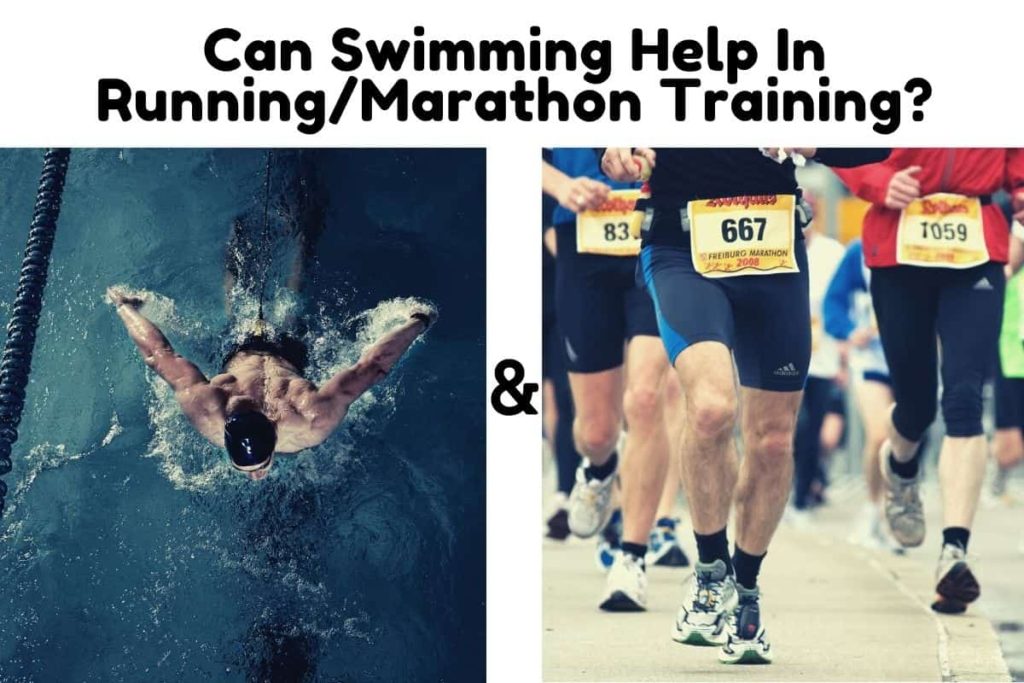The Centers for Disease Control and Prevention (CDC) states there are over 300 million visits to pools every year. This puts swimming in the top five recreational activities across the United States. While swimming is a popular leisure activity, it is an equally popular sport. And, not just as a stand-alone sport or as part of a triathlon, but for cross-training as well.
The idea of swimming as cross-training may conjure up some questions. What sports does it specifically compliment [well]? How does one implement it into their training?
Well, because swimming is low-impact and is a whole-body workout, it compliments pretty much any sport [well]. Also, it doesn’t require a lot of [expensive] equipment (i.e., cost a lot) to get started and/or implement in training.
With such questions surrounding swimming and its cross-training benefits, today’s article is focusing on swimming concerning marathon training (i.e., running). More specifically we will be diving into the question of whether (or not) swimming can help one’s marathon training.
Most any athlete knows that the best training schedule will be a mixture of strength and cardio training/workout sessions (as well as some flexibility/stretching)- both (all) are necessary for one’s [race] training to be most effective. Thus, to determine if swimming is beneficial to one’s marathon training, we would first need to look at the main reasons why runners (whether for marathons, triathlons, or just casually) cross-train in the first place (which are [to improve] endurance, speed, and recovery).
Swimming helps to improve all three of the goals of cross-training- [to improve one’s] endurance, speed, and recovery leading to improvement in one’s marathon (running) performance and is considered good training for the activity.
In fact, swimming has astonishing benefits for runners. It is one of the best cross-training methods for runners (for any athlete, really).
As such, many trainers, coaches, and medical professionals will recommend that runners- whether marathoners, triathletes, or just casual runners/joggers- include swimming in their training/cross-training schedule
Vice versa, check out our post addressing the question of “Is Running Good for Swimmers? How So!“

- 5 Benefits of Swimming for Runners
- Can Swimming Increase Running Stamina?
- Factors that Contribute to This Increased [running] Stamina From Swimming
- How Runners Should Do Swim Training?
- How Often Should Runners Swim?
- Is Swimming Good for Core Strengthening?
- 6 Core Exercises in The Water
- Could Swimming Be Bad for Runners?
- Can I Swim and Run on The Same Day? (4 Factors To Consider)
5 Benefits of Swimming for Runners
Here are five [specific] ways swimming can benefit runners and their marathon/running training
1- Swimming can help reduce common running injuries
The buoyancy of the water helps to reduce pressure on the body/body’s joints and alleviate stress on soft tissues (ligaments, muscles, and tendons). This in turn helps reduce the occurrence of common injuries associated with the constant impact [of the ground] that comes with running.
2- Swimming can help runners run faster
A 10-week study in the European Journal of Applied Physiology and Occupational Physiology shows that runners that incorporated swimming regularly into their training schedule throughout the study improved their run time for a 2-mile (3.2km) run by 13 seconds.
3- Swimming helps improve Cardiovascular performance
(as well as Increase/improve lung capacity)
Because swimming requires one to hold their breath for periodic bouts, swimming helps to improve cardiovascular performance as well as increase lung capacity. This is because while holding the breath, one’s body is being forced to work with the oxygen it has in the lungs.
Studies have shown this improved cardiovascular performance and increased lung capacity also improves one’s running economy (efficiency/effort).
4- Swimming can help strengthen one’s legs and ankles (builds muscle in general)
With water being about 12 times denser than air, swimming provides a fantastic form of resistance training (without the impact that land-based training can have). The constant kicking involved in swimming- whether with each stroke or via drills with kickboards or pull buoys- helps to build the muscles in the legs and ankles specifically.
But, swimming is a whole-body workout and, as such, helps to build and tone the muscles of the entire body in addition to those of the legs and ankles.
5- Swimming can help runners recover faster
One study in the International Journal of Sports of Medicine shows that a swimming-based recovery workout resulted in improved exercise (training/workout) performance the next day when compared to those that took a passive recovery day.
Though swimming has great benefits to one’s [marathon] running training, it is important to not dive headfirst into it (i.e., don’t swim too much too soon). From the outside looking in, swimming can seem like a simple sport but it does require some technique as it is a bit of a technical sport (much like running). Instead, take a patient and calculated approach to incorporating swimming into your training schedule. Going too hard, too fast (or doing too much, too soon) can result in developing bad technique(s) (mechanics) and/or injury.
Find out more in our article titled Why is Swimming and/or Hydrotherapy Often a Popular Choice for Physical Therapy?
Can Swimming Increase Running Stamina?
As was mentioned in the introduction to this article, runners cross-train for three main reasons- [to improve their] endurance (stamina), speed, and recovery. We also established that swimming can accomplish all three of those.
In General, it is safe to say that swimming does increase one’s stamina (endurance), not only in general but with particular regard to running [stamina/endurance]. Furthermore,
- One’s cardiovascular fitness is improved when swimming sprints. This in turn increases one’s agility and speed for running.
- One increases their endurance when they swim at a slower pace, but for a longer duration. This increased endurance from swimming will translate directly to one’s running.
In other words, as one increases their endurance in swimming their running endurance (stamina) will also increase.
Now that we know swimming can help improve (increase) one’s running stamina (endurance). Let’s look at two of the key factors that contribute to this increased [running] stamina
On a side note, check out our post titled “Is Cross-country Running Harder Than Swimming? Why!“
Factors that Contribute to This Increased [running] Stamina From Swimming
1- Swimming works different muscles
Not only does swimming have active recovery benefits such as helping to stretch the muscles runners utilize while running, but it helps runners strengthen the muscles not used while running. This helps to correct any muscular imbalances which ultimately helps to protect runners from injury and improve muscular endurance/stamina.
Not only does swimming build muscle, but it also actively stretches the entire body which aids one’s recovery (and improved recovery generally results in improved endurance during your next run/workout).
2- Swimming builds cardiovascular endurance and breath control (i.e., increases lung capacity)
Swimming also improves cardiovascular fitness via working the heart and lungs. It further improves one’s cardiovascular endurance by requiring the body to maintain movement for a certain duration. This requires one’s lungs to take in (breathe) oxygen (which is then used to fuel muscles).
In addition to an improvement in one’s cardiovascular endurance, swimming also brings a more profound awareness of one’s breath and how well one can regulate it while being physically active (i.e., swimming). When training in water (swimming), one is forced to be present and work with the conditions they find themself in as well as to breathe in a controlled manner.
This then translates to running as it can help one regulate their breathing and energy expenditures when training for (or running) a marathon outdoors where there may be more difficult (taxing) conditions/elements to contend with.
Additionally, some research indicates that when running, one’s breathing is typically shallow with a forceful exhalation. However, when swimming it is the opposite- one typically inhales deeply and quickly, and then slowly releases the breath (i.e., they let the breath “bleed” out, much like deflating a tire). This breathing technique- the one utilized in swimming- helps to increase one’s lung capacity.
The ability to control your breath and an increased lung capacity afford one the ability to properly pace their breathing and thereby increase their endurance (stamina) while running.
Thus, because swimming allows one to work on (improve) their breath control as well as increase their lung capacity (without the impact that comes with running), swimming does, indeed, help increase one’s running stamina (endurance)
As we can see a cross-training method that closely resembles running in many different ways, such as swimming, can certainly help to increase one’s running stamina (endurance), and, ultimately, improve one’s performance- especially on race day.
While swimming is a great cross-training workout for runners, when building out your [race] training schedule, it is important to remember that your swim workouts should complement (supplement) your runs for the week to maximize their benefits. (Source A)(Source B)(Source C)
How Runners Should Do Swim Training?
When incorporating swimming into their training schedule, one will want to start their swim with a warm-up. The [swim] workout itself should include drills to bring awareness to as well as to work on and correct inefficiencies in one’s mechanics (technique). Also, during the workout, one should include swimming at different speeds/efforts depending on their focus. Lastly, one will want to cool down (sometimes called warm down).
Based on this guideline for swim workouts, here is what an example swim workout for a runner might look like
- Warm-Up: 200 yards
- Drills (your choice): 8 x 50 yards
- Kicking: 100 (or more) yards (of nothing but kicks)
- Freestyle: 1000 yards (one can either swim it continuously as an aerobic swim or break into bouts of hard effort for 50 yards and easy/moderate effort for 100 yards until they reach 1000 yards)
- Cool(warm)-Down: 100 yards (easy effort)
While swimming is a great cross-training option, particularly for runners, one will get the most of their training/workout(s) when they track and monitor their swim workouts (i.e., track their swim metrics). This can be done via a heart rate monitor- whether it is a chest strap, clip-on monitor, watch, or combination thereof- and/or fitness app (much like you can track metrics for running). Newer to the market, they also have goggles that will track swim metrics (Amazon link).
When one tracks both their run and swim workouts (i.e., tracks the metrics for both their runs and swims) they get a more complete picture of their training. This complete training picture helps one to keep their training (and goals as well as effort) in perspective as well as to maximize the effects of their training and prevent injury.
Remember, you’re training for a marathon (i.e., a running event). As such, your training should be run-specific with swimming being a supplement/compliment. Swimming should be incorporated into one’s training in such a way that it does not hinder their running performance, but, rather, enhances it. (Source A)(Source B)(Source C)(Source D)
How Often Should Runners Swim?
Runners will want to avoid running too many miles over too many days consecutively. Running too much, too often is often how runners end up with injuries. As such, many health & wellness, as well as medical professionals, recommend that athletes avoid running on consecutive days. They further recommend swimming as a top choice for cross-training because it is low-impact and has a positive effect on run performance.
So, if one should be including swimming in their running training schedule, how often should they swim?
Ultimately it will depend on one’s training goals/priorities.
However, many professionals- health and wellness as well as medical- recommend that cross-training (including swimming ) should constitute 2-3 days of one’s training and running the other 3-4 days.
That said, of the 2-3 cross-training days, one of the cross-training days should be reserved for strength training (i.e., lifting weights and/or land-based bodyweight exercises). The other one or two days should be reserved for swimming ( a whole-body aerobic and anaerobic workout).
Additionally, it is worth noting that if your training schedule allows for an active rest day in addition to a passive rest day, swimming is a great option for your active rest (i.e., recovery) day activity/workout, especially as a runner. (Source A)(Source B)
Is Swimming Good for Core Strengthening?
When referring to one’s core it is exactly what it sounds like- the middle. In other words, one’s core is their middle. This is the part of the body that assists one in staying upright and maintaining good posture.
The core is also what helps one move around and do things like get up from a sitting position without having to hold on to something. It is also important to note that when referring to the core we are referring to muscles of both the abdomen (abdominal muscles) as well as those of the back (particularly the lower back).
Maintaining a strong and toned core is something many strive for. And, many know that swimming builds muscle. As such, one may be pondering whether or not swimming can help develop (and maintain) a strong and toned core.
When swimming, one utilizes muscles of the arms, legs, and core. In fact, the core muscles are constantly engaged to help one maintain their positioning in the water. This constant engagement results in increased strength.
So, yes, swimming is, indeed, good for building (and maintaining) core strength.
When swimming, one will want to concentrate on their technique rather than their speed. A great swim technique- one that coordinates arm movements (strokes) with kicks and where the body is elongated as if reaching for something just out of reach- will engage the core with a minimal concentration on doing so (i.e., one will strengthen their core while swimming without even, really, thinking about it).
6 Core Exercises in The Water
In addition to swimming (laps/drills), one can also do some specific exercises in the water that will help strengthen their core. Here are a few exercises that target the core that one can do the next time they are in the water
1- Kickboard Kicks
- Hold a kickboard in front of you, arms fully extended, and kick your feet (note: one can practice all kicks with this method- freestyle, backstroke, breaststroke, and butterfly)
- While doing this, imagine pulling your belly button toward your spine and away from the bottom of the pool (or ocean) (i.e., think of sucking in your stomach while “bracing for impact”)
- Continue like this for the length of the pool, or until you can no longer safely continue
2- Pikes
- Stand in water that is just up to your neck, pull your knees into your chest
- Lean back. Straighten/extend your legs out into a pike position. ( Your body should be in a “v” shape with your buttocks toward the pool/ocean floor.)
- Hold this position, using your arms (pushing them backward in circles)
- Hold the position for as long as you safely can (ideally, at least a few seconds). Rest, and, then repeat up to ten times
3- Tic-Toc
- Stand in shallow water (i.e., waist level or lower) with your feet shoulder-width apart
- Lean over to one side until the arm on that side is underwater up to the elbow
- Come back to center (an upright position) slowly, contracting those abdominal muscles tightly as you do so
- Lean over to the other side and do the same thing
- Repeat up to eight times on each side
4- Flutter Kicks
- Hold on to the edge of the pool or use a noodle to keep your upper body afloat. Assure your feet cannot touch the bottom.
- Let your legs hang toward the bottom of the pool (they should not touch the bottom though)
- Kick your feet in a scissor motion, front-to-back, rapidly. Be sure to keep your legs straight and your toes pointed as you kick.
- Continue this movement for as long as is comfortable (and safe) for you to do so
5- Dolphin Kick
- Hold a kickboard out in front of you to start (or outstretch clasped hands in front of you)
- Engage your core muscles (i.e., tighten your abdominal muscles) to move your body in a wave-like motion to move your body forward through the water. (i.e., push your chest down while keeping your hips up, then push your hips down as your chest comes back up)
- Repeat this movement until you have gone the length of the pool or until you are tired and cannot continue with the exercise safely
6- Swimming with a (pull) buoy
- Place the pull buoy between your thighs or ankles (for a greater challenge you can place a strap around your ankles versus using a pull buoy)
- Begin swimming freestyle (front crawl). Be sure to keep your feet together and Do Not kick. The pull buoy will keep your legs afloat, allowing you to concentrate on your upper body (and core).
- Keep your hips and feet from sinking by engaging your core throughout the exercise
- Continue with this exercise for the length of the pool or until you are fatigued and cannot safely continue
As we can see swimming does indeed provide a good core workout (i.e., swimming builds core strength). And, bonus, you don’t even have to really concentrate on engaging your core because it just happens naturally given the demands of the activity/sport. The biggest things to concentrate on are stretching out your body as far as you can (i.e., elongating your body) and kicking fully (i.e., kicking powerfully)- in doing this, one’s core will work naturally (i.e., the core will naturally engage).
Also, you don’t have to just swim laps to work the core. You can try out [some of] the exercises above to break things up and still strengthen your core (without the impact and stress that land-based core exercises typically have).
While swimming is great for building (and maintaining) core strength, one will also want to consider safety. If you become overly fatigued and/or feel pain/discomfort, stop the exercise(s) and take a break outside of the pool. (Source A)(Source B)
Could Swimming Be Bad for Runners?
Swimming is an excellent cardiovascular workout that has a very low injury risk due to its low-impact nature. As we know, this is [part of] what makes it a great cross-training workout for runners. With all this talk of all the benefits of swimming, one may be wondering if swimming could be bad for runners?
According to research (and in my own humble opinion), there are very few adverse effects of swimming- not only in general but concerning runners, specifically, as well. While (as with any physical activity) there is [always] an inherent risk of injury/adverse effects, swimming, by and large, due to the natural properties of water that make swimming low-impact, has an extremely low propensity for such.
Of course, there are always outliers and exceptions to the rule(s) and there is, most definitely, such a thing as “too much of a good thing”. And, while overall swimming poses very little risk of being bad for runners (or any athlete), one of those exceptions concerns breaststroke.
Breaststroke tends to be the worst swimming stroke for runners. The frog-like kick that accompanies the breaststroke often irritates [existing] patellofemoral pain (i.e., pain in the front of the knee), which is common amongst runners.
Also, check out Does Swimming Have Any Negatives?! (Drawbacks Listed).
And find out “Why Do Swimmers Have Broad Shoulders, Flabby Arms and Big Thighs ?!“
So, again, swimming, ultimately, poses a very little risk (i.e., isn’t bad) for runners generally speaking. However, to be on the safe side, one may want to avoid the breaststroke (at least the kick) if they are a runner- especially if they experience pain in the front of their knee(s) (patellofemoral pain in one or both knee/s). (Source A)(Source B)
Can I Swim and Run on The Same Day? (4 Factors To Consider)
When training for intense sports such as a marathon, it can be a fine art to juggle the training. Especially when your training schedule includes multiple workouts in a day.
Perhaps you are one of those with an intense training schedule trying to figure out what workouts you can pair together (i.e., do on the same day). As such, you may be wondering if you can swim and run on the same day.
Ultimately this is going to depend on your training goals and whether or not your training plan has specified when your workouts are to take place.
Typically, if your workout/training is specified this means it is done at a specific time. Most often this specific (specified) time immediately follows one’s run.
An unspecified workout/training typically means it is to be done separately. In other words, you would do one workout in the morning and one in the evening (from several different forums, many prefer to swim in the mornings and run in the evenings, but it would be a matter of your specific training goals, workout(s), and/or preference).
Other factors to consider when deciding whether or not it will be appropriate for you to swim on the same day(s) that you run include
1- Type of activity
Different activities cause varying degrees of muscle tissue breakdown (trauma). Running causes the most amount of trauma while swimming causes the least. You’ll want to avoid doubling up on workouts of the same type. (Thus, swimming and running on the same day could very well be acceptable depending on your training goals)
2- Intensity
Generally, you will want your first workout to be the most intense to minimize the risk of injury and maximize the gains of the training session. However, some people are “night owls”/ function better in the evening, and, as such, they may opt to put their more intense workout as their second workout/later in the day. Consider the intensity of your workout, your training goals, and how you best function when scheduling your training. Be sure to allow for proper recovery between training/workout sessions.
3- Experience
All athletes have their [individual] strengths and weaknesses- runners are no exception. Plan your training/workout sessions according to your strengths (and weaknesses) to maximize the effects and benefits of your training on your race/event day performance.
4- Fuel
Nutrition before, during, and after any training/workout session is important in general. It becomes critical on days when one will be doubling up on training/workout sessions. One will want to assure they eat within 30 minutes of their first training/workout session to properly replenish nutrient stores, namely carbs, for their second training/workout session.
In general, it is typically safe to swim and run on the same day. However, if you are an athlete, it will ultimately depend on what your training goal(s) is(are).
Regardless of whether you are an athlete or not, if you are considering scheduling your swim and run training/workout sessions on the same day you will want to take into account your activity type(s), the intensity of the activity(ies), your experience in each activity (i.e., your strengths and weaknesses within each activity), and your fuel (nutrition) before, during, and after training/workouts- particularly your first workout- when developing your training/workout schedule. (Source)


